Types of House Moths (With Pictures) – Identification and Control Guide
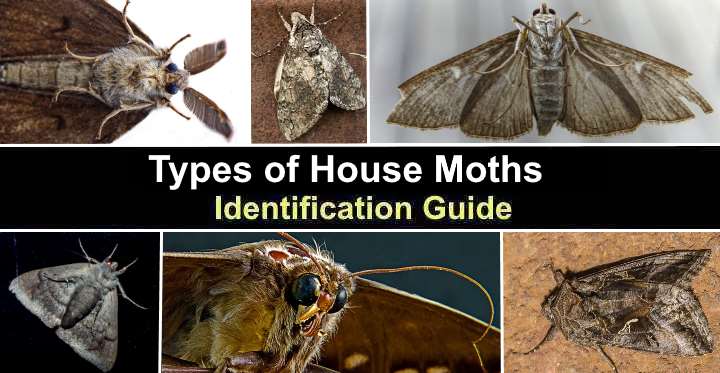
House moths are common household pests that no one wants to discover flying around their home. These pesky flying insects may not bite, but they can cause damage to stored food items, clothing, and soft furnishings. In addition, if you’ve got moths in your house, you probably have moth larvae lurking in crevices or — worse still — in stored grain, flour, sugar, rice, pasta, or dried beans.
Identifying types of house moths can help you know how to get rid of them. For example, common pantry moths tend to live in or around foodstuffs near your kitchen, garbage can, or pet food. However, clothes moths are typically found in closets where they chew holes in woolen clothing.
This article is a guide to identifying types of house moths you typically find indoors. Pictures and descriptions of these tiny brown, tan, or gray flying insects will help identify them. At the end of the article, you’ll get helpful tips on getting rid of house moths for good and how to prevent them from returning.
What is a House Moth?
A house moth is a general term for types of small flying insects commonly found in homes. Moths belong to the insect order Lepidoptera — the same as butterflies and large outdoor moths. Depending on their food source, most people refer to them as pantry moths or clothes moths.
Like all species of moths, a house moth starts life as an egg which then hatches into a larva or tiny white caterpillar. These little white bugs feed on organic matter, allowing them to grow larger. The larvae pupate, and then the tiny moths emerge.
Knowing the life cycle of house moths helps to get rid of them. However, it’s also good to note that the destructive pests are typically moth larvae, not the flying adult moths. These nasty bugs attack fibers and grains, leaving holes in clothes, feces, and shed skins after they molt.
For example, suppose you see tiny brown or gray insects fluttering in your kitchen or coming out of closets. That means there are likely moth larvae somewhere. So, just killing the house moths doesn’t get rid of them for good. Instead, you must find where the eggs and larvae are and eradicate them.
How to Identify House Moths
You can identify a species of house moth by noting its color, size, and length of antennae. Most types of house moths are recognized by mottled patterns on their wings. Many also have tan, gray, or brown-colored fuzzy bodies and wings. Depending on the species, house moths measure between 0.23” and 0.55” (6 – 14 mm), excluding their wingspan.
Like all types of insects, house moths have a three-section body consisting of a head, thorax, and abdomen.
Common Types of House Moths (With Pictures) — Identification
There are a few species of moths that typically live indoors. These are small creatures with furry bodies and wings. But, of course, larger moths can also find their way into homes through open windows when attracted to lights in the evening time.
In this article, we’ll only look at the identifying features of six common types of house moths.
Brown House Moth (Hofmannophila pseudospretella)
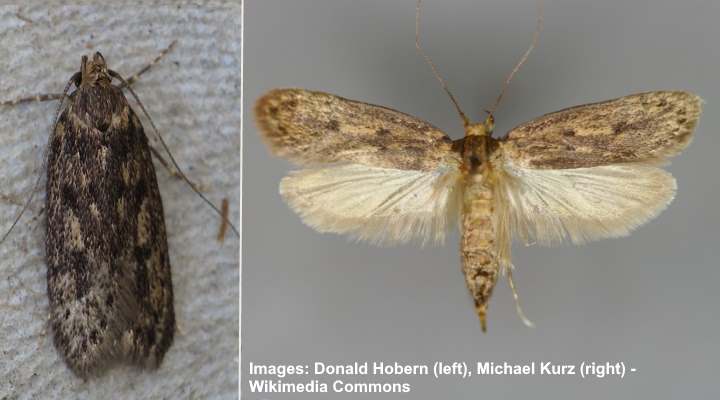
The common brown house moth has brown-gray speckled forewings and lighter hindwings without markings
The brown house moth is a small tan insect with gray and dark brown mottled wing patterns. Distinguishing features of the fuzzy brown moth are its pale-brown forewings and cream-colored hind wings. Both sets of wings have dark, blackish-brown patches. The small brown moths also have slender, thread-like antennae.
Brown house moths range in size from 0.31” to 0.55” (8 – 14 mm) long and have a wingspan of up to 1” (25 mm). Although the flying house pests are more active in summer, you can find them at any time of the year.
Brown house moths are considered pests in homes because of the damage the larvae do. The tiny white caterpillars feed on stored cereals, seeds, fabric, clothes, and leather. Sometimes, they can also leave holes in carpets and clothing made from synthetic fibers.
House moth identification
The brown house moth is identified by its large wings, like dragonfly wings, that are brown and tan with black spots and mottled patterns.
White Shouldered House Moth (Endrosis sarcitrella)
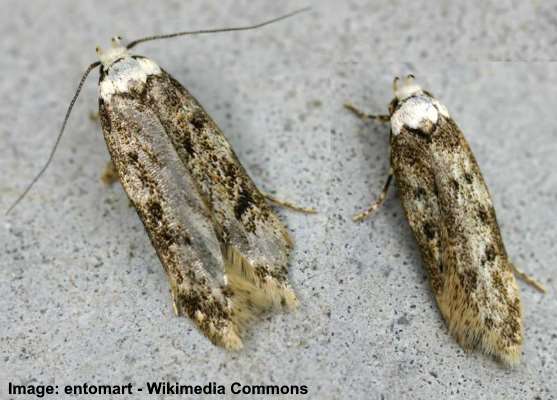
The white shouldered house moth is identified by its white head and white patch behind the thorax
The white-shouldered house moth is a grayish flying insect with a distinctive white patch just behind its thorax. Other distinguishing features of the fuzzy moth are its long thread-like antennae, white head, and hind wings with feathery setae. These relatively large harmless moths measure 0.59” to 0.82” (15 – 21 mm).
Like all types of house moths, the larvae of the white-shouldered moth do the damage. The tiny grub-like bugs feed on dried fruits, cereal, seeds, and dry plant debris. The white caterpillars with their brown heads grow up to 0.47” (12 mm) long.
Indoors, the annoying house bugs can be active at any time of the year.
House moth identification
The distinctive feature of the white-shouldered house moth is its white head with a large white patch behind its thorax. In addition, its gray to light brown wings are lightly mottled.
Common Clothes Moth (Tineola bisselliella)
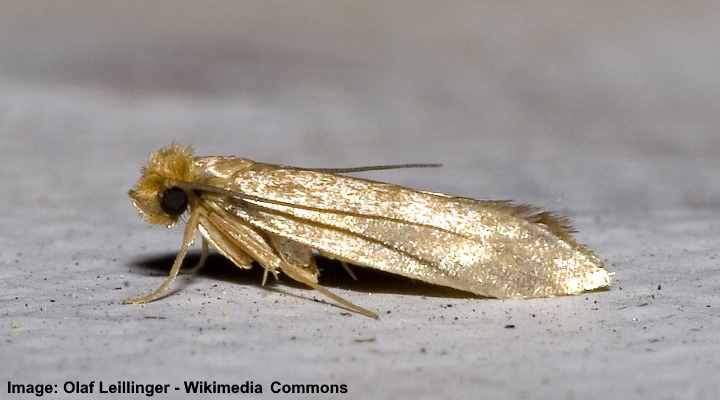
The clothes moth is a little grayish-beige bug whose larvae cause damage to natural fabrics
The common clothes moth is a small beige or light tan colored moth with narrow wings fringed with fine hairs. These tiny house moths have a slender, tapered body and roundish beige head with two thread-like antennae. Up close, pictures of the house moth reveal a reddish-brown tuft of hair on its head.
Also called the clothing moth or webbing clothes moth, this house moth measures 0.24” to 0.28” (6 – 7 mm) long. However, it’s difficult to spot the annoying pest because they prefer dark places like closets, wardrobes, attics, and basements.
Clothing moths are considered small house bugs because of their grub-like caterpillars. These white worm-like creatures feed on wool, silk, felt, and fur. Therefore, signs of these clothes-destroying creatures are holes in clothing made from natural fibers.
House moth identification
The clothes moth is identified by its beige or buff-colored wings and slender body that tapers at the tail end.
Case-Bearing Clothes Moth (Tinea pellionella)

The tiny case-bearing clothes moth has a mottled brown color and its larvae feeds on fibers and wallpaper
The case-bearing clothes moth is a destructive pest in homes. The house moth is identified by its mottled brown color, a brown tuft of hair on its head, and fine grayish hairs on its wing tips. The wing patterns are lightly mottled with one large dark spot and several indistinct smaller ones.
Case-bearing clothes moths are tiny fly-like creatures measuring 0.24” to 0.28” (6 – 7 mm). Related to Tineola bisselliella, the small house moths are distinguished by their darker color and three spots on their wings.
Typical of all house moths, the larvae of case-bearing clothes moths are the insects that cause the damage. The beige-colored worm-like bugs form cases around themselves from fibers when it feeds on carpets, woolen fabrics, wallpaper, and upholstery.
Have you noticed holes in carpets, thinking they could be from moth larvae? While these creatures can do damage, the holes could be caused by destructive carpet beetles.
House moth identification
Case-bearing clothes moths are small insects with slender wings, dark brownish-black mottled wings, and several indistinct black spots on them.
Mediterranean Flour Moth (Ephestia kuehniella)

The Mediterranean flour moth is a mottled gray house bug whose larvae feeds on some dried food products
Also called the mill moth, the Mediterranean flour moth has grayish wings with black and tan mottled patterns and a wavy black and gray pattern across the center. This gray house moth also has contrasting hind wings that are an off-white color. The moths grow to 0.90” (23 mm) long.
Mediterranean flour moths damage cereal products when in their larval stage. The small white or pink caterpillars feed on flour, whole grains, and cornmeal. However, unlike other pantry moths, these pests don’t infest other dried food products.
House moth identification
The Mediterranean flour moth is identified by its black and gray zigzag pattern across its blackish-gray mottled wings.
Indian Meal Moth (Plodia interpunctella)
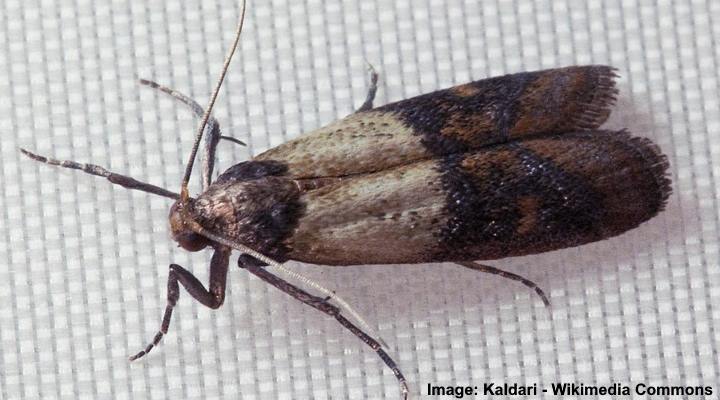
The brown and gray Indian meal moth is commonly found in kitchens and pantries in grain products
The Indian meal moth is a dark brown pantry moth that is a significant pest in kitchens. The moth’s forewings are an identifiable dark bronze and dark gray color with black mottled patterns on the lower half. Typically, the hind wings are light gray with visible veining patterns.
The Indian meal moth measures 0.31” to 0.39” (8 – 10 mm) with a wingspan up to 0.78” (25 mm) wide. The common house moth is sometimes called the weevil moth, flour moth, grain moth, or pantry moth.
Indian meal moth larvae are highly destructive house pests. The grub-like caterpillars chew through thin cardboard and plastic. And they can infest a wide range of dried foodstuffs like bread, pasta, flour, spices, nuts, dried fruits, and rice. The house bugs are notoriously challenging to eradicate.
House moth identification
The Indian meal moth is identified by its bi-colored forewings that are dark bronze to brown on the lower half and mottled gray on the upper half.
How to Get Rid of House Moths
To get rid of house moths, it’s crucial to discard any items — food or clothing — where the moth eggs and larvae may reside. Additionally, use a vacuum cleaner or swatter to kill any moths you see flying around. Then thoroughly clean all surfaces with soapy water or a vinegar solution to disinfect surfaces.
How to Get Rid of Pantry Moths
Have you noticed signs of pantry moths in your kitchen closets or flying around food prep areas? The pesky moths may not infect food, but they lay eggs that hatch into annoying larvae, which then feed on various foodstuffs. If you notice the moths, you will likely need to find the eggs and larvae and kill them.
Here are four ways to get rid of pantry moths:
Remove infested food to get rid of pantry moths
The first step to eradicating pantry moths is to discard any contaminated food. Signs of pantry moth larvae are tiny maggots or webbing dangling inside food packets. Typically, you’ll need to remove everything from your pantry and check all cereal packets, pasta, grains, rice, and similar items.
Clean cupboards and shelves to eliminate pantry moths
The next step to eliminate pantry moths is to wipe down the inside of all kitchen cabinets and units where you store food. First, use the vacuum cleaner to get rid of all debris and microscopic eggs. Next, make a bug spray by combining equal parts of vinegar and water. Then, spray on surfaces and wipe dry with a clean cloth.
Store food in storage containers to prevent pantry moths
You can get rid of pantry moths for good by always storing cereals, dried grain products, pasta, flour, and similar foodstuffs in airtight, sealable containers. Remember that a cereal box and the internal packaging is no match for pesky house moth larvae.
Kill pantry moth larvae by freezing food
Before storing food in your kitchen cabinets, you can ensure you’ve killed the moth eggs and larvae for good by freezing food. So, put your grains and other dried foods in the freezer overnight just to be sure.
How to Get Rid of Clothes Moths
Clothes moths can be challenging to eradicate because they tend to lurk in dark, undisturbed places like the inside of closets. The signs of a clothes moth infestation could be small holes in woolen clothing, frass (insect excrement) that looks like pepper grinds, or molted skins. You may even discover the small white larvae or cream-colored eggs.
Here are some tips on getting rid of clothes moths for good:
Identify the house moths
The first step in eradicating clothes moths is to confirm their identity. This is crucial because other house bugs can also chew holes in clothing, destroy carpets, or leave frass behind. For example, carpet beetles, larder beetles, and hide beetles could be the culprits. If you identify clothes moths or their larvae, the next step is to treat the area to kill the bugs.
Discard heavily infested clothing to get rid of clothes moths
Check clothing for signs of moth damage. If it is heavily infested — i.e., the garment is riddled with holes — you will have to discard the items. To prevent the moths from doing more damage, it’s crucial to put the damaged clothes in a sealable trash can liner.
Clean clothing to get rid of clothes moths
Dry cleaning is an effective way to kill clothes moths, their eggs, and larvae. This is sometimes necessary because moth larvae tend to damage delicate items you can’t wash in hot temperatures. For example, cashmere sweaters, mohair scarves, or wool jackets can be dry cleaned without the risk of them shrinking.
Freeze clothes to eliminate house moths
Freezing clothes is an effective treatment method to kill moth larvae. This is a good moth-killing tactic for items you cannot clean in a washing machine or dry clean. Instead, put the items into sealed plastic bags and freeze them for 72 hours. This is enough time to kill the nasty caterpillars.
After freezing the clothing, let it thaw naturally, shake the items over the bathtub to remove any frozen eggs or larvae, and rinse the dead bugs down the drain.
Heating kills clothes moths
Putting infested clothing in the drier is another way to kill clothes moths for good. So, ensure the drier is at its hottest setting — over 120°F (48°C) is enough heat to kill fabric-destroying bugs. Then put the drier on for at least 30 minutes to get rid of the moth caterpillars.
How to Prevent House Moths
After eradicating house moths, prevention is crucial to avoid more infestations. And the best way to prevent a future infestation is to eliminate any potential sources of food and shelter for these nasty bugs. So here are some top tips on ensuring any problems with moths are kept to a minimum.
Keep pet food covered
Avoid attracting moths and house beetles to your home by not leaving pet food out overnight. Many types of larder moths are attracted to food and moisture. Therefore, a bowl of pet food with water beside it will attract unwanted guests.
Store food in airtight jars
Storing food in airtight containers is one of the best ways of preventing pantry moths. At the same time, you’ll also help avoid a roach or larder beetle infestation. So, don’t use plastic bags or cardboard boxes, as many types of larvae can chew through that kind of packaging.
Store clothes in vacuum-sealable bags
After thoroughly cleaning closets and ensuring no signs of moth activity, you can store clothing in a vacuum-sealable bag or a tightly sealed plastic tote bag. This keeps delicate, natural fiber clothing in a protected, sealed environment — well away from fabric-chewing bugs.
Use cedar lining in closets to prevent house moths
Some people recommend using cedar linings or blocks in closets to prevent moths from breeding there. The idea is that cedar scents repel moths and stop them from laying eggs in your drawers or closets. However, even if cedar does work for preventing moths, it doesn’t have a repelling effect on eggs and larvae.
Use pheromone moth traps to stop moths from coming back
If you have identified the house moths as webbing clothes moths (Tineola bisselliella), then you can try pheromone traps to kill moths and prevent infestations. These attract male clothes moths and, even though they don’t stop female moths from laying eggs, they disrupt the mating process.
Keep surfaces clean
One of the most crucial ways to prevent a moth infestation is to regularly clean surfaces. Therefore, always wipe down surfaces after using them to prevent crumbs and other potential food sources in your kitchen. Similarly, ensure that crumbs and other small bits of grains don’t accumulate in kitchen cabinets.
Related articles:
